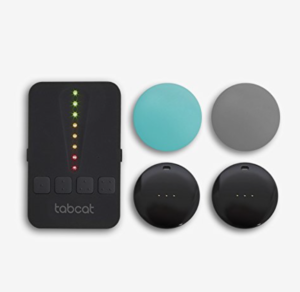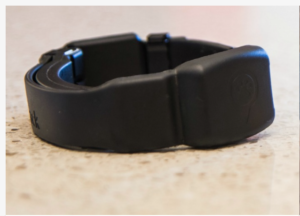The simple answer is battery life.
My requirements for a cat tracker are:
- Very long battery life (around 3 months). I don’t want to be changing batteries all the time. The one day I forget to change the battery will be the day when Buttons decides to go an investigate next door’s shed, I know it.
- GPS-level accuracy.
- The ability to remotely find out where your cat currently is, allowing you to find him if he’s lost.
- Small enough and light enough for a cat to carry around (obviously!).
All of the GPS-based cat trackers I could find had battery life that was measured in days, rather than months. I’ve had a look at the most popular ones below.
Pawtrack
This device is the top Google hit for “cat tracker”. Clearly a decent product, with thousands of users, but the battery life is quoted as “2-3 days”. There’s no way I am going to be bothered chasing Buttons round the house trying to change the battery every 2 days.
The £125 up-front cost isn’t bad but £5 a month is a bit annoying. It’ll be especially annoying when the pawtrack people decide that they don’t want to run the servers anymore.
Tractive GPS Tracker
![]()
Seems to be a less polished version of pawtrack. Same deal – GPS receiver and cellular modem with a similar monthly rate to pawtrack. The up-front cost is cheaper, but if the Amazon reviews are to be believed, it’s a lot worse.
Tabcat Detector

Yes, detector.
Despite the slightly unusual name, this one isn’t actually that bad. I know this because it’s what I currently use to keep track of Buttons.
The device works in a completely different way to the previous two. There’s no GPS receiver and no cellular modem. The good news is that means that there is also no monthly charge! The bad news is that you can’t see the location of your cat on a map.
The way it works is that the base unit gives you an indication of how close you are to your cat and which direction it is in. You swing the unit round and follow the beeps until you stumble upon Buttons fast asleep in a bush, before wondering why you were so worried in the first place.
The batteries last several months (woo!), but annoyingly you have to be within about 40-50 metres of your cat for it to work. It’s not a huge issue, but it’d be nice to see where he is on a map without having to put your shoes on and wander the streets in your dressing gown.
What I’d like to design is basically a combination of the above products. GPS level accuracy from a product with a battery-life measured in months.

Interesting project.
Why does your battery last so long compared to commercial products?
I guess one reason it’s the fact that you don’t use a cellular connection to send the data. But are there other reasons? Maybe commercial products use too powerful controllers?
Hi Lucas.
This reply is enormously slow, apologies.
I think the lack of cellular and the fact that I am not always sending the position back to some kind of basestation is the key. I sit in a very low power state 99.99% of the time.
You may be interested to hear that I am working on a version 2… watch this space!
I’ve just stumbled on this while researching small, long lived (genuine) GPS trackers – I found a load of GPRS, SIM card type that claim to be GPS and which have no accuracy at all. Totally useless.
Then I found your creation! Wow!
To get this straight: you created a long life, highly accurate, GPS tracker that allows on demand tracking AND is light weight and slimline AND you don’t need to pay a subscription AND there’s NO SIM CARD!?!! And you did this a coupe of years ago?!?
You sir are amazing!
The best I’ve found commercially, while it does look very nice: it’s embedded in the collar and its (chunky) catch, so it’s almost invisible and looks like a normal (of cheap and nasty) collar. It still costs a couple of £s a month to subscribe to, and it needs an app, so it has a SIM too (and lower battery life).
What I’m saying is, even the best commercial version of this I’ve found isn’t actually better than your design – it’s just different and has its own strengths and weaknesses – it only lasts 1 day (maybe 2 at a push) in “transmit” mode for example. It does have the ability to remotely flash some LEDs to aid visibility when searching, if required, which sounds nice but probably isn’t worth it in reality. A buzzer would probably have been more useful actually, from a search and rescue perspective.
Anyway, sorry to ramble, I’m just so impressed at what you achieved and how you reached your goal that I felt compelled to send you a note.
I’d love to buy the boards and have a bash at building one of these. Do you sell the bare boards by chance? Or even the components (the programmed PIC chips and the GPS particularly) and the printed boards for self assembly?
This is exactly the kind of thing I would love to have ago at building for my cat.
What’s the total weight by the way? And have you refined the design at all since completion?
Congrats on a fantastic project and on creating such a fascinating diary / log of how you achieved it all.
Hi Duncan.
Firstly apologies for the mega slow reply! Something was wrong with the comments system that prevented me from seeing this.
You may be interested to hear that I am working on a version 2… the case will be the same size but I expect the battery life to be even longer (6 months hopefully!) and it’ll be a lot easier to solder, with fewer components. Oh, and it’ll have a buzzer, to aid finding the cat if he or she are hiding in a bush somewhere.
Watch this space..!
I will be able to provide PCBs, yes. You’ll be able to order them yourself from oshpark. I’ve ordered all the parts for v2, I’m just waiting for them to arrive.
Feel free to get in touch on andy@burningimage.net 🙂
Hi Andy,
I’m a mechanical engineer also in the UK, and my girlfriend has one of the Tractive units which lasts about 2 days on battery. I also have a beer brewing monitor that lasts over 6 months on an 18650. I don’t need to know how many steps my cat has done, I just want deep sleep with an update on location every ~15 minutes. It’s an outlandish concept, but I thought the company could make what data is sent and how often configurable? But from their product evolution it’s obvious they’re either grossly incompetent or actively trying to make the battery need replacing early. The tracker holder design adds weight to their underhanded intentions… £4.50 per month for data?!
I was playing with the idea of building one with LoRaWAN but I know it would involve a custom PCB to be small and light enough. As a mechanical engineer that’s probably achievable, but I’d make a lot of mistakes along the way, waste a lot of money prototyping, and it’d take many months to get it working.
I thought someone else must have had the same idea and had the skills to make it real. And I’m so glad you have! EXCELLENT WORK!